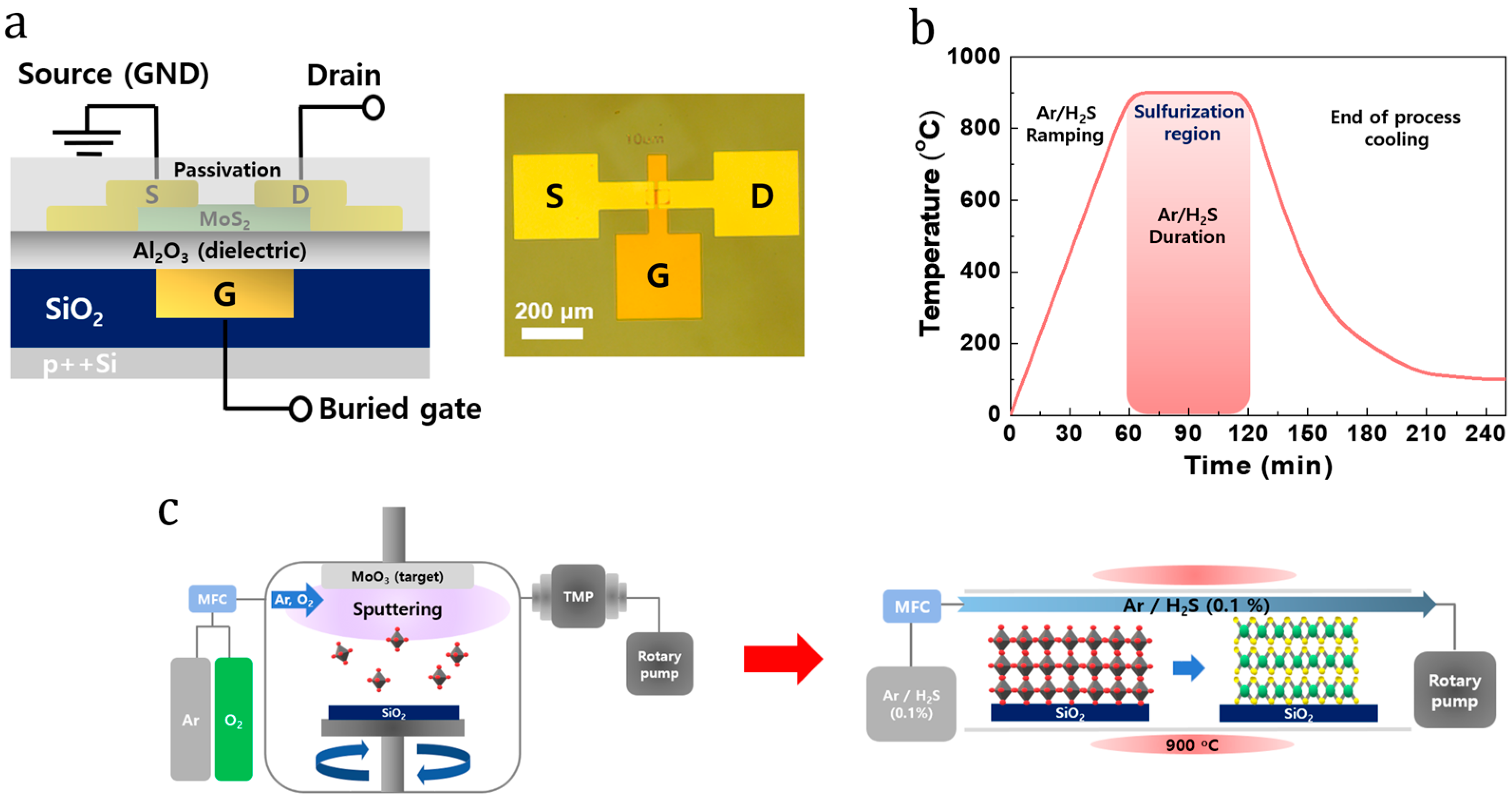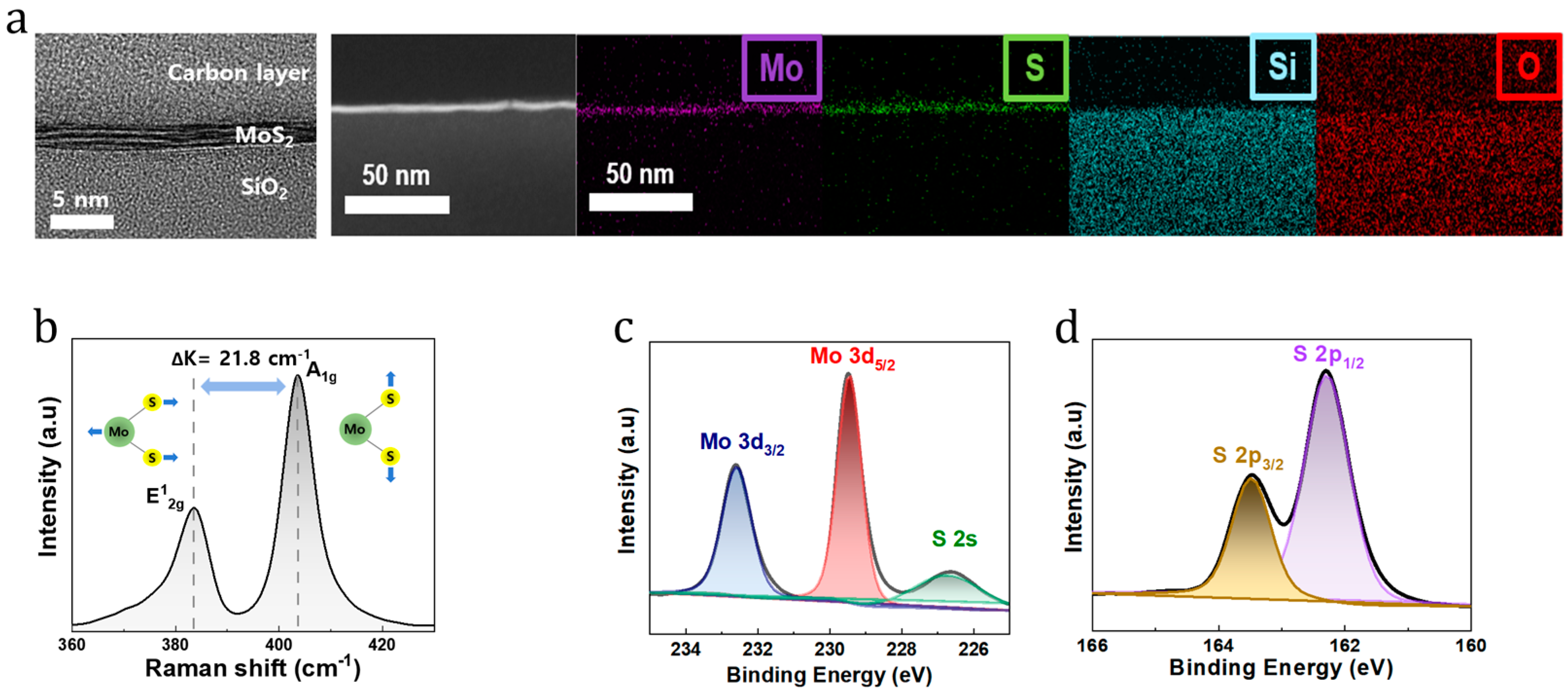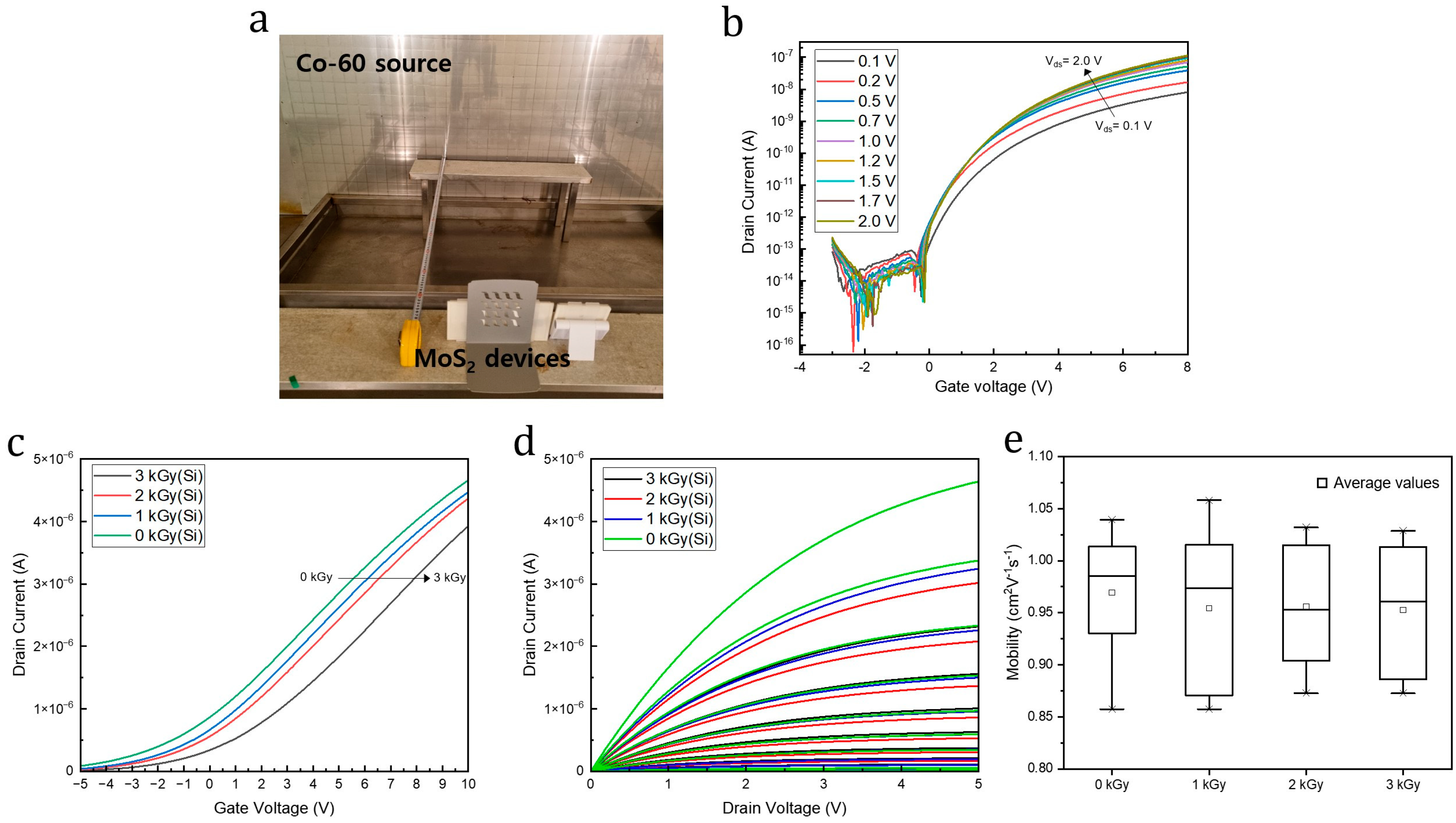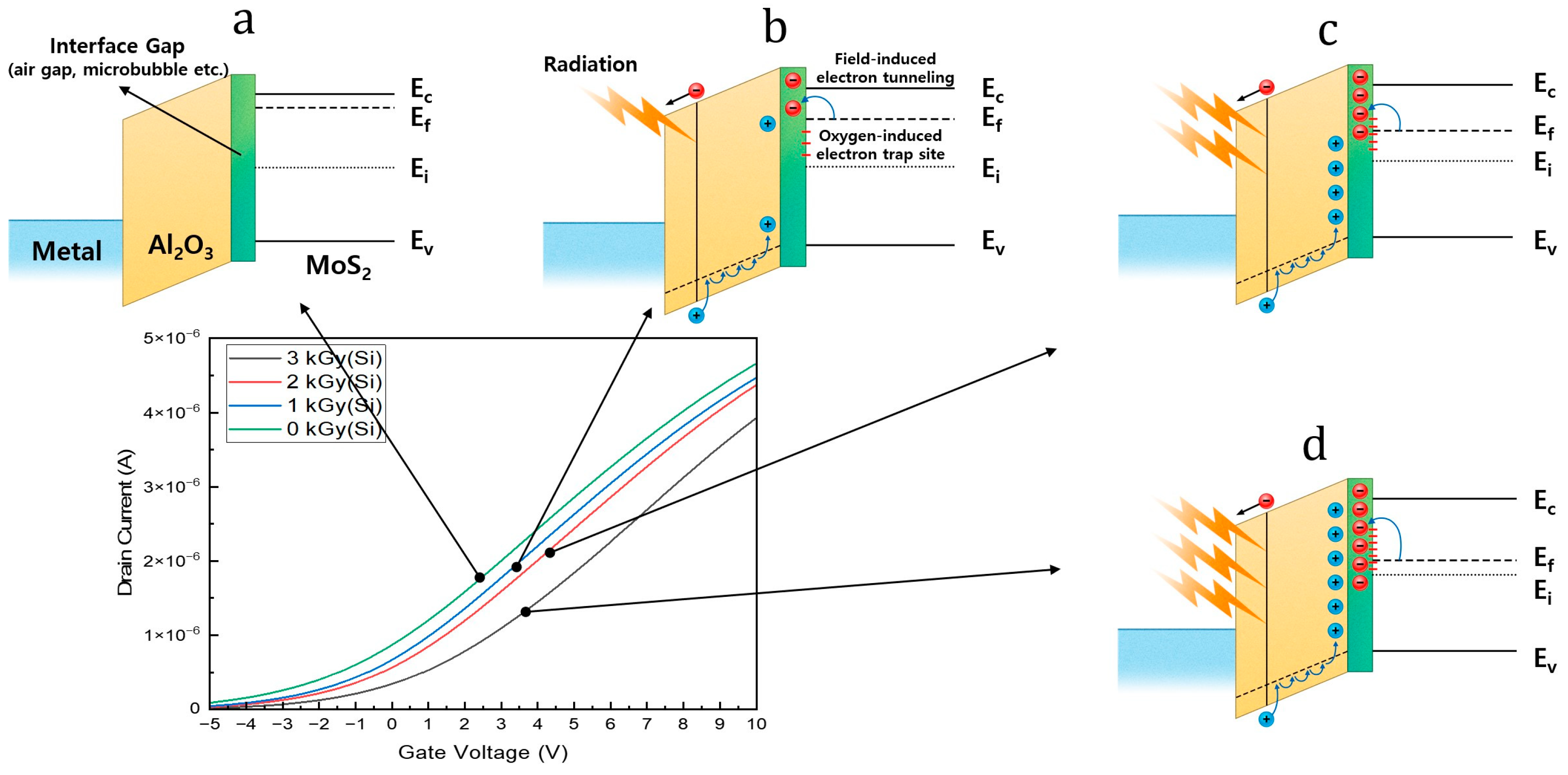Gamma-Irradiation-Induced Electrical Characteristic Variations in MoS2 Field-Effect Transistors with Buried Local Back-Gate Structure
Abstract
:1. Introduction
2. Materials and Methods
2.1. Device Fabrication
2.2. Characterization of MoS2 Film
3. Results and Discussion
3.1. Synthesis of MoS2 on SiO2 Substrate
3.2. Material Characteristics of the MoS2 Thin Films on the SiO2 Wafers
3.3. Gamma Irradiation Test Results for MoS2 Buried Local Back-Gate Transistors
3.4. Mechanism of Electrical Characteristics Changing According to Gamma Irradiation Dose
4. Conclusions
Author Contributions
Funding
Data Availability Statement
Conflicts of Interest
References
- Khan, K.; Tareen, A.K.; Aslam, M.; Wang, R.; Zhang, Y.; Mahmood, A.; Ouyang, Z.; Zhang, H.; Guo, Z. Recent developments in emerging two-dimensional materials and their applications. J. Mater. Chem. C 2020, 8, 387–440. [Google Scholar] [CrossRef]
- Al-Saleh, M.H. Electrical and mechanical properties of graphene/carbon tube hybrid nanocomposites. Synth. Met. 2015, 209, 41–46. [Google Scholar] [CrossRef]
- Akinwande, D.; Brennan, C.J.; Bunch, J.S.; Egberts, P.; Felts, R.; Gao, H.; Huang, R.; Kim, J.-S.; Li, T.; Li, Y.; et al. A review on mechanics and mechanical properties of 2D materials–graphene and beyond. Extrem. Mech. Lett. 2016, 13, 42–77. [Google Scholar] [CrossRef]
- Wang, S.Y.; Ko, T.S.; Huang, C.C.; Lin, D.Y.; Huang, Y.S. Optical and electrical properties of MoS2 and Fe-doped MoS2. Jpn. J. Appl. Phys. 2014, 53, 04EH07. [Google Scholar] [CrossRef]
- Vincent, T.; Liang, J.; Singh, S.; Castanon, E.G.; Zhang, X.; McCreary, A.; Jariwala, D.; Kazakova, O.; Al Balushi, Z.Y. Opportunities in electrically tunable 2D materials beyond graphene: Recent progress and future outlook. Appl. Phys. Rev. 2021, 8, 041320. [Google Scholar] [CrossRef]
- Lembke, D.; Kis, A. Breakdown of high-performance monolayer MoS2 transistors. ACS Nano 2012, 6, 10070–10075. [Google Scholar] [CrossRef] [PubMed]
- Podzorov, V.; Gershenson, M.E.; Kloc, C.; Zeis, R.; Bucher, E. High-mobility field-effect transistors based on transition metal dichalcogenides. Appl. Phys. Lett. 2004, 84, 3301–3303. [Google Scholar] [CrossRef]
- Radisavljevic, B.; Radenovic, A.; Brivio, J.; Giacometti, V.; Kis, A. Single-layer MoS2 transistors. Nat. Nanotechnol. 2011, 6, 147–150. [Google Scholar] [CrossRef] [PubMed]
- Xu, J.; Chen, L.; Dai, Y.-W.; Cao, Q.; Sun, Q.-Q.; Ding, S.-J.; Zhu, H.; Zhang, D.W. A two-dimensional semiconductor transistor with boosted gate control and sensing ability. Sci. Adv. 2017, 3, e1602246. [Google Scholar] [CrossRef]
- Mak, K.F.; Lee, C.; Hone, J.; Shan, J.; Heinz, T.F. Atomically thin MoS2: A new direct-gap semiconductor. Phys. Rev. Lett. 2010, 105, 136805. [Google Scholar] [CrossRef]
- Wang, Q.H.; Kalantar-Zadeh, K.; Kis, A.; Coleman, J.N.; Strano, M.S. Electronics and optoelectronics of two-dimensional transition metal dichalcogenides. Nat. Nanotechnol. 2012, 7, 699–712. [Google Scholar] [CrossRef] [PubMed]
- Arutchelvan, G.; Smets, Q.; Verreck, D.; Ahmed, Z.; Gaur, A.; Sutar, S.; Jussot, J.; Groven, B.; Heyns, M.; Lin, D.; et al. Impact of device scaling on the electrical properties of MoS2 field-effect transistors. Sci. Rep. 2021, 11, 6610. [Google Scholar] [CrossRef] [PubMed]
- Kumar, A.; Faella, E.; Durante, O.; Giubileo, F.; Pelella, A.; Viscardi, L.; Intonti, K.; Sleziona, S.; Schleberger, M.; Di Bartolomeo, A. Optoelectronic Memory in 2D MoS2 Field Effect Transistor. J. Phys. Chem. Solids 2023, 179, 111406. [Google Scholar] [CrossRef]
- Di Bartolomeo, A.; Kumar, A.; Durante, O.; Sessa, A.; Faella, E.; Viscardi, L.; Intonti, K.; Giubileo, F.; Martucciello, N.; Romano, P.; et al. Temperature-Dependent Photoconductivity in Two-Dimensional MoS2 Transistors. Mater. Today Nano 2023, 24, 100382. [Google Scholar] [CrossRef]
- Isherwood, L.H.; Athwal, G.; Spencer, B.F.; Casiraghi, C.; Baidak, A. Gamma radiation-induced oxidation, doping, and etching of two-dimensional MoS2 crystals. J. Phys. Chem. C Nanomater. Interfaces 2021, 125, 4211–4222. [Google Scholar] [CrossRef] [PubMed]
- Vogl, T.; Sripathy, K.; Sharma, A.; Reddy, P.; Sullivan, J.; Machacek, J.R.; Zhang, L.; Karouta, F.; Buchler, B.C.; Doherty, M.W.; et al. Radiation tolerance of two-dimensional material-based devices for space applications. Nat. Commun. 2019, 10, 1202. [Google Scholar] [CrossRef] [PubMed]
- Ozden, B.; Khanal, M.P.; Park, J.; Uprety, S.; Mirkhani, V.; Yapabandara, K.; Kim, K.; Kuroda, M.; Bozack, M.J.; Choi, W.; et al. Raman and X-ray photoelectron spectroscopy investigation of the effect of gamma-ray irradiation on MoS2. Micro Nano Lett. 2017, 12, 271–274. [Google Scholar] [CrossRef]
- Chen, D.; Li, J.; Wei, Z.; Wei, X.; Zhu, M.; Liu, J.; Zhang, G.; Zhang, Z.; Chen, J.-H. Repairable polymer solid electrolyte gated MoS2 field effect devices with large radiation tolerance. Adv. Electron. Mater. 2022, 8, 2100619. [Google Scholar] [CrossRef]
- Song, X.; Guo, Z.; Zhang, Q.; Zhou, P.; Bao, W.; Zhang, D.W. Progress of large-scale synthesis and electronic device application of two-dimensional transition metal dichalcogenides. Small 2017, 13, 1700098. [Google Scholar] [CrossRef]
- Chen, J.; Shao, K.; Yang, W.; Tang, W.; Zhou, J.; He, Q.; Wu, Y.; Zhang, C.; Li, X.; Yang, X.; et al. Synthesis of wafer-scale monolayer WS2 crystals toward the application in integrated electronic devices. ACS Appl. Mater. Interfaces 2019, 11, 19381–19387. [Google Scholar] [CrossRef]
- Yu, H.; Liao, M.; Zhao, W.; Liu, G.; Zhou, X.J.; Wei, Z.; Xu, X.; Liu, K.; Hu, Z.; Deng, K.; et al. Wafer-scale growth and transfer of highly-oriented monolayer MoS2 continuous films. ACS Nano 2017, 11, 12001–12007. [Google Scholar] [CrossRef] [PubMed]
- Wang, Q.; Li, N.; Tang, J.; Zhu, J.; Zhang, Q.; Jia, Q.; Lu, Y.; Wei, Z.; Yu, H.; Zhao, Y.; et al. Wafer-scale highly oriented monolayer MoS2 with large domain sizes. Nano Lett. 2020, 20, 7193–7199. [Google Scholar] [CrossRef] [PubMed]
- Choudhary, N.; Park, J.; Hwang, J.Y.; Choi, W. Growth of large scale and thickness-modulated MoS2 nanosheets. ACS Appl. Mater. Interfaces 2014, 6, 21215–21222. [Google Scholar] [CrossRef] [PubMed]
- Seok, H.; Megra, Y.T.; Kanade, C.K.; Cho, J.; Kanade, V.K.; Kim, M.; Lee, I.; Yoo, P.J.; Kim, H.U.; Suk, J.; et al. Low-temperature synthesis of wafer-scale MoS2−WS2 vertical heterostructures by single-step penetrative plasma sulfurization. ACS Nano 2021, 1, 707–718. [Google Scholar] [CrossRef] [PubMed]
- Choudhary, N.; Patel, M.D.; Park, J.; Sirota, B.; Choi, W. Synthesis of large scale MoS2 for electronics and energy applications. J. Mater. Res. 2016, 31, 824–831. [Google Scholar] [CrossRef]
- Chubarov, M.; Choudhury, T.H.; Hickey, D.R.; Bachu, S.; Zhang, T.; Sebastian, A.; Bansal, A.; Zhu, H.; Trainor, N.; Das, S.; et al. Wafer-scale epitaxial growth of unidirectional WS2 monolayers on sapphire. ACS Nano 2021, 15, 2532–2541. [Google Scholar] [CrossRef] [PubMed]
- Kim, Y.; Kim, A.R.; Zhao, G.; Choi, S.Y.; Kang, S.C.; Lim, S.K.; Lee, K.E.; Park, J.; Lee, B.H.; Hahm, M.G.; et al. Wafer-scale integration of highly uniform and scalable MoS2 transistors. ACS Appl. Mater. Interfaces 2017, 9, 37146–37153. [Google Scholar] [CrossRef]
- Hwang, S.; Hwang, Y.; Park, B.; Ah Lee, J.; Choi, D.H.; Ra Kim, A.; Lee, S.K.; Kwon, J.D.; Kwon, S.H.; Kim, Y. A facile approach towards wrinkle-Free transfer of 2D-MoS2 films via hydrophilic Si3N4 substrate. Appl. Surf. Sci. 2022, 604, 154523. [Google Scholar] [CrossRef]
- Yang, S.; Liu, K.; Xu, Y.; Liu, L.; Li, H.; Zhai, T. Gate dielectrics integration for 2D electronics: Challenges, advances, and outlook. Adv. Mater. 2023, 35, e2207901. [Google Scholar] [CrossRef]
- Zheng, Y.; Gao, J.; Han, C.; Chen, W. Ohmic contact engineering for two-dimensional materials. Physiol. Sci. 2021, 2, 100298. [Google Scholar] [CrossRef]
- Lee, J.A.; Yoon, J.; Hwang, S.; Hwang, H.; Kwon, J.D.; Lee, S.K.; Kim, Y. Integrated logic circuits based on wafer-scale 2D-MoS2 FETs using buried-gate structures. Nanomaterials 2023, 13, 2870. [Google Scholar] [CrossRef]
- Eda, G.; Yamaguchi, H.; Voiry, D.; Fujita, T.; Chen, M.; Chhowalla, M. Photoluminescence from chemically exfoliated MoS2. Nano Lett. 2011, 11, 5111–5116. [Google Scholar] [CrossRef] [PubMed]
- Lee, C.; Yan, H.; Brus, L.E.; Heinz, T.F.; Hone, J.; Ryu, S. Anomalous lattice vibrations of single- and few-layer MoS2. ACS Nano 2010, 4, 2695–2700. [Google Scholar] [CrossRef]
- Najmaei, S.; Liu, Z.; Zhou, W.; Zou, X.; Shi, G.; Lei, S.; Yakobson, B.I.; Idrobo, J.C.; Ajayan, P.M.; Lou, J. Vapor phase growth and grain boundary structure of molybdenum disulphide atomic layers. Nat. Mater. 2013, 12, 754–759. [Google Scholar] [CrossRef] [PubMed]
- Kaushal, P.; Khanna, G. The role of 2-dimensional materials for electronic devices. Mater. Sci. Semicond. Process. 2022, 143, 106546. [Google Scholar] [CrossRef]
- He, Y.; Xiang, X.; Wu, Z.; Li, M.; Deng, H.; Zhang, J.; Yang, G.; Chen, H.; Yuan, Y.; Zu, X. γ-Ray Dose Dependent Conductivity of MoS2 Nanomaterials at Different Temperatures. CrystEngComm 2019, 21, 6830–6837. [Google Scholar] [CrossRef]
- Singh, A.; Singh, R. γ-Ray Irradiation-Induced Chemical and Structural Changes in CVD Monolayer MoS2. ECS J. Solid State Sci. Technol. 2020, 9, 093011. [Google Scholar] [CrossRef]
- Kim, T.Y.; Cho, K.; Park, W.; Park, J.; Song, Y.; Hong, S.; Hong, W.K.; Lee, T. Irradiation effects of high-energy proton beams on MoS2 field effect transistors. ACS Nano 2014, 8, 2774–2781. [Google Scholar] [CrossRef] [PubMed]
- Lu, M.-Y.; Wu, S.-C.; Wang, H.-C.; Lu, M.-P. Time-evolution of the electrical characteristics of MoS2 field-effect transistors after electron beam irradiation. Phys. Chem. Chem. Phys. 2018, 20, 9038–9044. [Google Scholar] [CrossRef]
- Bartolomeo, A.D.; Genovese, L.; Giubileo, F.; Iemmo, L.; Luongo, G.; Foller, T.; Schleberger, M. Hysteresis in the transfer characteristics of MoS2 transistors. 2D Mater. 2018, 5, 015014. [Google Scholar] [CrossRef]
- Zhang, X.; Zhu, H.; Peng, S.; Xiong, G.; Zhu, C.; Huang, X.; Cao, S.; Zhang, J.; Yan, Y.; Yao, Y.; et al. Radiation-hardened property of single-walled carbon nanotube film-based field-effect transistors under low-energy proton irradiation. J. Semicond. 2021, 42, 112002. [Google Scholar] [CrossRef]
- Zhao, Y.; Li, D.; Xiao, L.; Liu, J.; Xiao, X.; Li, G.; Jin, Y.; Jiang, K.; Wang, J.; Fan, S.; et al. Radiation effects and radiation hardness solutions for single-walled carbon nanotube-based thin film transistors and logic devices. Carbon 2016, 108, 363–371. [Google Scholar] [CrossRef]
- Kang, C.G.; Lee, Y.G.; Lee, S.K.; Park, E.; Cho, C.; Lim, S.K.; Hwang, H.J.; Lee, B.H. Mechanism of the effects of low temperature Al2O3 passivation on graphene field effect transistors. Carbon 2013, 53, 182–187. [Google Scholar] [CrossRef]
- Lee, Y.G.; Kang, C.G.; Cho, C.; Kim, Y.; Hwang, H.J.; Lee, B.H. Quantitative analysis of hysteretic reactions at the interface of graphene and SiO2 using the short pulse I–V method. Carbon 2013, 60, 453–460. [Google Scholar] [CrossRef]
- Zhang, C.X.; Newaz, A.K.M.; Wang, B.; Zhang, E.X.; Duan, G.X.; Fleetwood, D.M.; Alles, M.L.; Schrimpf, R.D.; Bolotin, K.I.; Pantelides, S.T. Electrical stress and total ionizing dose effects on MoS2 transistors. IEEE Trans. Nucl. Sci. 2014, 61, 2862–2867. [Google Scholar] [CrossRef]




Disclaimer/Publisher’s Note: The statements, opinions and data contained in all publications are solely those of the individual author(s) and contributor(s) and not of MDPI and/or the editor(s). MDPI and/or the editor(s) disclaim responsibility for any injury to people or property resulting from any ideas, methods, instructions or products referred to in the content. |
© 2024 by the authors. Licensee MDPI, Basel, Switzerland. This article is an open access article distributed under the terms and conditions of the Creative Commons Attribution (CC BY) license (https://creativecommons.org/licenses/by/4.0/).
Share and Cite
Kim, S.J.; Hwang, S.; Kwon, J.-D.; Yoon, J.; Park, J.M.; Lee, Y.; Kim, Y.; Kang, C.G. Gamma-Irradiation-Induced Electrical Characteristic Variations in MoS2 Field-Effect Transistors with Buried Local Back-Gate Structure. Nanomaterials 2024, 14, 1324. https://doi.org/10.3390/nano14161324
Kim SJ, Hwang S, Kwon J-D, Yoon J, Park JM, Lee Y, Kim Y, Kang CG. Gamma-Irradiation-Induced Electrical Characteristic Variations in MoS2 Field-Effect Transistors with Buried Local Back-Gate Structure. Nanomaterials. 2024; 14(16):1324. https://doi.org/10.3390/nano14161324
Chicago/Turabian StyleKim, Su Jin, Seungkwon Hwang, Jung-Dae Kwon, Jongwon Yoon, Jeong Min Park, Yongsu Lee, Yonghun Kim, and Chang Goo Kang. 2024. "Gamma-Irradiation-Induced Electrical Characteristic Variations in MoS2 Field-Effect Transistors with Buried Local Back-Gate Structure" Nanomaterials 14, no. 16: 1324. https://doi.org/10.3390/nano14161324
APA StyleKim, S. J., Hwang, S., Kwon, J.-D., Yoon, J., Park, J. M., Lee, Y., Kim, Y., & Kang, C. G. (2024). Gamma-Irradiation-Induced Electrical Characteristic Variations in MoS2 Field-Effect Transistors with Buried Local Back-Gate Structure. Nanomaterials, 14(16), 1324. https://doi.org/10.3390/nano14161324






